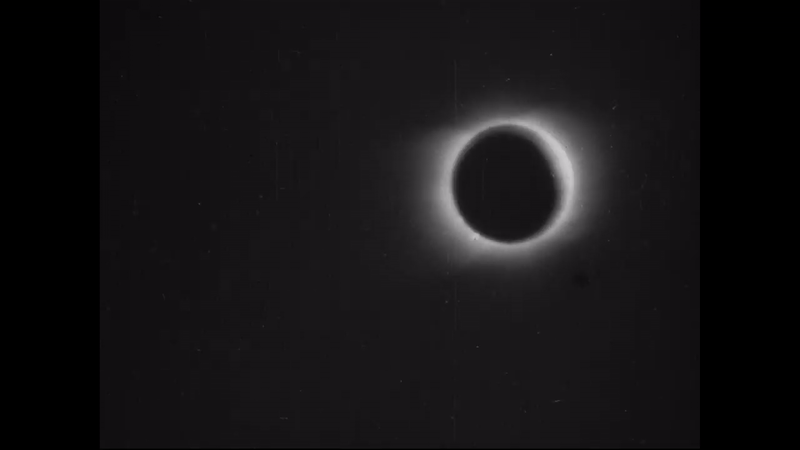Magician's Film of 1900 Solar Eclipse Is World's Oldest Astronomical Movie (And It's Pure Magic)
Magicians are known for making things disappear, but when the sun vanished from the sky on May 28, 1900, it happened not through a sleight of hand, but because of a solar eclipse.
There was magic in the air that day after all — movie magic. Nevil Maskelyne, a performing magician who also happened to be a pioneering filmmaker, preserved the spectacular event — as the moon passed between Earth and the sun — on celluloid, from a location in North Carolina.
More than a century later, Maskelyne's film of the eclipse has been digitally scanned and restored in a collaboration between the Royal Astronomical Society (RAS) and the British Film Institute (BFI), and is free to view online. The film, titled "Solar Eclipse," is thought to be the world's oldest surviving astronomical film, Joshua Nall, chair of the RAS Astronomical Heritage Committee, said in a statement. [ In Images: Solar Eclipses Depicted in Fine Art]
From film's earliest days at the dawn of the 20th century, Maskelyne recognized the medium's potential for entertainment and education, according to the statement. His interest in astronomy led him to the RAS; he became a fellow in the society and traveled to North Carolina in 1900 on an expedition with the British Astronomical Association, to film the solar eclipse.
The film is brief, lasting just over a minute. On the right of the screen, the sun is covered by the moon's shadow, with only a thin band of light visible around the upper right portion of the dark disk. Gradually, the glowing ring extends around the perimeter of the disk, until the sun emerges from the left.
Maskelyne designed a special lens attachment — called a cinematograph telescope — for his movie camera to film the eclipse, said Bryony Dixon, BFI curator of silent film.
"He had previously taken out a patent for engineering equipment, so it’s not beyond the realms of possibility that he may have developed his own camera to capture this event," Dixon told Live Science in an email. But as the original British Astronomical Society report about the film doesn’t mention whether Maskelyne used a camera of his own invention to shoot the eclipse, "it’s something we’ll probably never know for sure."
Get the world’s most fascinating discoveries delivered straight to your inbox.
Even more remarkably, Maskelyne successfully captured the challenging exposure changes as the eclipse progressed. [ Amazing Astronomy: Victorian-Era Illustrations of the Heavens]
"The diamond ring effect of the corona at totality affects the exposure of the image," Dixon said. "Maskelyne was able to change the exposure and camera aperture as the event occurred, tracing the gradual fading of the corona in increasing sunlight."
In 1900, Maskelyn screened "Solar Eclipse" for the Royal Astronomical Society and the general public at the Egyptian Hall in Piccadilly — London's most popular magic stage at the time — "as part of a bigger program of magic and illusionist acts," Dixon said.
RAS archivists brought the film to the BFI in 2018, where experts scanned the 120-year-old celluloid and began the process of digitizing it. A BFI conservation team copied the original, frame by frame, to 35 millimeter film and scanned every frame digitally.
"The original film was shot at five or six frames per second; when the original film was scanned at the BFI National Archive, it was retimed at nine frames per second, creating a stable image with less flicker," Dixon said.
The digitized "Solar Eclipse" was shared online as part of the BFI's "Victorian Film" project; 500 British films produced between 1895 and 1901 are now publicly available for the first time, to commemorate the 200th anniversary of the birth of Queen Victoria (May 24, 1819), according to the project's website.
"These new media pioneers recorded the world of the late Victorians themselves with an avid curiosity in the world opening up around them," Dixon said in the email.
"120 years on, these films give modern audiences an immediacy and deeper understanding of the Victorian period than has been felt before. Like HG Wells' time traveller we are transported back — you almost feel you can reach out and touch the past."
- Spaced Out! 101 Astronomy Images That Will Blow Your Mind
- Photos: The Adventure Behind Eclipse Chasing
- 10 Solar Eclipses That Changed Science
Originally published on Live Science.

Mindy Weisberger is a science journalist and author of "Rise of the Zombie Bugs: The Surprising Science of Parasitic Mind-Control" (Hopkins Press). She formerly edited for Scholastic and was a channel editor and senior writer for Live Science. She has reported on general science, covering climate change, paleontology, biology and space. Mindy studied film at Columbia University; prior to LS, she produced, wrote and directed media for the American Museum of Natural History in NYC. Her videos about dinosaurs, astrophysics, biodiversity and evolution appear in museums and science centers worldwide, earning awards such as the CINE Golden Eagle and the Communicator Award of Excellence. Her writing has also appeared in Scientific American, The Washington Post, How It Works Magazine and CNN.



